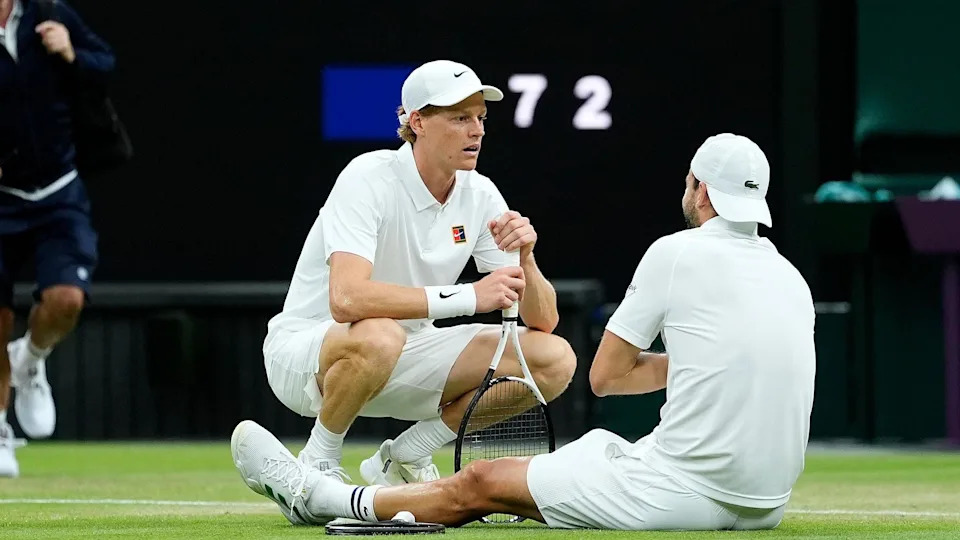As the NFL’s November 4th trade deadline rapidly approaches, the league stands at a pivotal crossroads. Week 9 results will definitively sort contenders from teams looking toward the future, triggering a flurry of strategic roster adjustments. Playoff-bound teams are scrambling to fortify weaknesses, while those facing an uphill battle are seeking to accrue future assets. This dynamic environment sets the stage for high-stakes decisions by general managers across the league.
USA TODAY’s seasoned NFL insiders – Nate Davis, Jacob Camenker, Michael Middlehurst-Schwartz, and Nick Brinkerhoff – have unveiled their most anticipated and impactful trade deadline deals. Their predictions offer a compelling glimpse into potential player movements that could reshape the 2025 season. Notably, the Los Angeles Chargers emerge as a prominent potential buyer in several proposed scenarios, signaling their aggressive intent to upgrade.
The Shifting NFL Trade Landscape: Buyers, Sellers, and Shockwaves
The competitive landscape of the 2025 NFL season is exceptionally tight, with a remarkable 13 teams boasting at least five wins through Week 8. This intense competition elevates the significance of the trade deadline, making Week 9 outcomes critical for guiding team strategies. We’ve already seen significant pre-deadline activity, indicating an active market. Veteran quarterback Joe Flacco moved in an intrastate deal between the Cleveland Browns and Cincinnati Bengals. The Browns also swapped cornerback Greg Newsome II for Jacksonville’s Tyson Campbell. Baltimore and Los Angeles Chargers executed a notable trade involving Odafe Oweh and Alohi Gilman, demonstrating the Chargers’ early commitment to upgrading their roster. The Los Angeles Rams also acquired Roger McCreary from the Tennessee Titans.
Teams like the Dallas Cowboys, according to owner Jerry Jones, are “open for business,” actively seeking to improve. Jones emphasized a desire for “top percentile” talent—players who “love football,” are “self-motivators,” and become “miserable when they don’t play well.” Conversely, teams like the Tennessee Titans are widely expected to be “sellers,” having already moved McCreary, though they’ve reportedly deemed quarterback Cam Ward and defensive lineman Jeffery Simmons “untouchable.”
USA TODAY Insiders’ Bold Trade Predictions for Impact Players
The following proposed deals highlight key areas of need and opportunity, showcasing how a single transaction can significantly alter a team’s trajectory. These insights dive deep into the strategic rationale for both the acquiring and parting teams.
Indianapolis Colts Target Elite Edge Rush with Jaelan Phillips (Dolphins OLB)
The Indianapolis Colts, currently leading the NFL with a surprising 7-1 record, are a legitimate resurgence story. Their success, fueled by a “career renaissance” from quarterback Daniel Jones and the league-leading efforts of running back Jonathan Taylor (1,056 scrimmage yards, 14 scrimmage touchdowns), positions them as significant buyers. However, to truly contend with elite playoff offenses led by talents like Patrick Mahomes and Josh Allen, their pass rush needs a boost.
While the Colts rank second in pressure rate (39.9%), they are merely average in sack rate (6.57%) and allow the fourth-highest time to throw (2.90 seconds). This suggests Indianapolis isn’t consistently forcing quarterbacks into bad spots, reflected in their 26th-ranked defensive success rate (46.38%). Miami Dolphins outside linebacker Jaelan Phillips could provide the missing “jolt” opposite Laiatu Latu. Despite two previous season-ending injuries, Phillips offers the explosive edge presence and coverage versatility that defensive coordinator Lou Anarumo seeks. With the Dolphins currently struggling at 2-6 and facing widespread rumors of a “significant teardown”—including inquiries about star receiver Jaylen Waddle—a trade involving Phillips becomes a more plausible scenario for Miami to gain valuable draft capital, even if they initially express reluctance.
Los Angeles Chargers Bolster Backfield with Rico Dowdle (Panthers RB)
The Los Angeles Chargers are in urgent need of running back depth. With Najee Harris (Achilles) and rookie Omarion Hampton (ankle) sidelined, and Hampton’s return timeline uncertain, Kimani Vidal has admirably stepped up but lacks established support. The Chargers have already shown their intent to upgrade, recently acquiring edge rusher Odafe Oweh and making inquiries about additional running backs and offensive linemen. Adding a reliable option at running back is paramount for coach Jim Harbaugh and offensive coordinator Greg Roman.
Rico Dowdle, 27, from the Carolina Panthers, presents an ideal fit. His solid size (5-11, 215 pounds), contact balance, and power would take pressure off the smaller Vidal. Dowdle could handle early-down duties, allowing Vidal—who has shown well in pass protection—to excel in third-down situations. Dowdle has been productive this season, accumulating 605 yards and two touchdowns on 106 carries, outperforming Chuba Hubbard. While the 4-4 Panthers might be hesitant to part with a contributor, Dowdle is playing on an expiring one-year deal, making him a prime candidate for Carolina to acquire assets rather than lose him for nothing in free agency.
Chargers Eye Veteran Leadership, QB Insurance with Russell Wilson (Giants QB)
Justin Herbert, the Chargers’ franchise quarterback, has endured a barrage of hits behind a “patchwork blocking” offensive line this season. Despite this, the Chargers’ current backup quarterback situation—featuring long-on-potential-short-on-proof Trey Lance and practice squad rookie DJ Uiagalelei—is described as “uninspiring.” An injury to Herbert, even for a few weeks, could derail their season.
While 36-year-old Russell Wilson is “clearly limited” at this stage of his 14-year career, he could provide crucial “insurance.” Acquiring Wilson’s remaining contract is projected to cost the Chargers approximately $1 million for 2025, a minimal investment for a veteran who could enable the team to “survive a 4-6 week injury” to Herbert. This move would also allow Lance and Uiagalelei to continue their development under quarterback guru Jim Harbaugh. For the New York Giants, the benefit of Wilson’s presence for young quarterback Jaxson Dart is diminishing. With veteran Jameis Winston under contract through 2026, the Giants are well-positioned at the position. Trading Wilson could net them a “low-level pick swap,” securing some draft capital for a player who doesn’t align with their future plans.
Kansas City Chiefs Seek Explosive Backfield Upgrade with Breece Hall (Jets RB)
The Kansas City Chiefs, engaged in a fierce “AFC West arms race,” are actively seeking to upgrade their running back position. Breece Hall, the talented New York Jets running back, could be the dynamic playmaker to elevate Andy Reid’s offense to “another level.” Hall, who entered the league with immense promise, has openly expressed the “weight of losing” with the Jets, a franchise enduring the league’s longest playoff drought and seemingly heading for yet another rebuild. Hall’s recent frustration with the team’s performance has been palpable.
The Jets’ commitment to a rebuild is further evidenced by their recent trade of cornerback Michael Carter II to the Philadelphia Eagles for wide receiver John Metchie III and draft capital. This move signals their intent to accrue assets and retool the roster. With Hall set to become a free agent after the season, his departure appears increasingly likely, especially with multiple playoff contenders reportedly interested. His recent “showcase game,” where he tossed a game-winning touchdown pass and added two rushing scores against the Bengals, only amplifies his trade value. Dealing Hall now for draft picks makes strategic sense for the rebuilding Jets.
What Drives These Trade Dynamics?
These proposed trades are not random; they are fueled by a confluence of strategic considerations. Teams act as buyers when they perceive a clear path to the playoffs and believe a specific player can fill a critical roster hole, providing a tangible boost for a Super Bowl push. Conversely, sellers recognize their diminishing playoff hopes and opt to convert valuable players into future draft capital or cap flexibility, accelerating a rebuilding process.
Crucial elements driving these decisions include player contracts (expiring deals often lead to trades), salary cap implications, and the overall team philosophy. Jerry Jones’s emphasis on acquiring players who are not only talented but also culturally aligned and self-motivated highlights the intricate balance between skill and team fit. Ultimately, general managers weigh immediate gains against long-term stability, constantly recalibrating their approach as the season unfolds.
Frequently Asked Questions
What factors are driving NFL teams to be buyers or sellers at the 2025 trade deadline?
The NFL trade deadline on November 4th is heavily influenced by Week 9 game outcomes, which clarify which teams are playoff contenders (“buyers”) and which are falling out of contention (“sellers”). Teams with strong records, like the 7-1 Indianapolis Colts, are motivated to acquire talent to solidify playoff runs. Struggling teams, such as the 2-6 Miami Dolphins or the rebuilding New York Jets, often become sellers, looking to offload players on expiring contracts or those who don’t fit their long-term timeline, in exchange for draft picks or cap relief. Player contracts, injury situations, and a team’s current financial health also play significant roles.
Which teams are highlighted as active participants or key targets in the proposed trade scenarios?
The Los Angeles Chargers are prominently featured as significant buyers, seeking to bolster their running back depth with Rico Dowdle and secure quarterback insurance with Russell Wilson. They have already demonstrated active participation by acquiring Odafe Oweh. The Indianapolis Colts are buyers targeting edge rusher Jaelan Phillips. On the selling side, the Miami Dolphins (Phillips), Carolina Panthers (Dowdle), New York Giants (Wilson), and New York Jets (Hall) are highlighted as potential trade partners, looking to optimize their rosters or gain future assets amidst varying team contexts from struggling records to rebuilding phases.
How might a team like the Los Angeles Chargers strategically use the trade deadline to bolster their roster for a playoff run?
The Los Angeles Chargers, already active with the acquisition of Odafe Oweh, are strategically using the trade deadline to address critical roster holes impacting their playoff aspirations. Their focus includes bolstering a depleted running back corps (as seen with the proposed Rico Dowdle trade) and securing a reliable backup quarterback for Justin Herbert (like Russell Wilson) to mitigate risks behind a “patchwork blocking” offensive line. These moves aim to provide immediate impact and depth, ensuring the team can sustain performance through the season’s stretch run and into the playoffs, demonstrating a clear “win-now” mentality while carefully managing financial implications.
The Final Countdown: High Stakes for the 2025 NFL Trade Deadline
The clock is ticking down to the 2025 NFL trade deadline, and the insights from USA TODAY’s experts underscore the strategic intensity permeating the league. These proposed deals are more than just speculation; they represent calculated moves that could either solidify championship aspirations or lay the groundwork for future success. As teams make their final strategic assessments, the coming days are set to deliver impactful player movements that will undoubtedly shape the remainder of the season and beyond.



